| Share |  |
 | |||
Breaking Free from Sugar Addiction
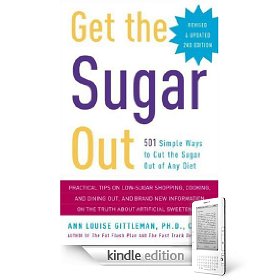 Even though we may understand what happens inside our bodies when refined sugar and carbohydrates are consumed and how they negatively impact our health, it is not always an easy matter in today’s society to get sugar out of our diets. It seems as though sugar-laden foods and treats are found everywhere, not to mention that three quarters of the sugars that Americans eat are “hidden” in processed foods that may not even be regarded as sweet. Our taste buds and appetites become addicted to these foods and beverages without our even realizing it!
Even though we may understand what happens inside our bodies when refined sugar and carbohydrates are consumed and how they negatively impact our health, it is not always an easy matter in today’s society to get sugar out of our diets. It seems as though sugar-laden foods and treats are found everywhere, not to mention that three quarters of the sugars that Americans eat are “hidden” in processed foods that may not even be regarded as sweet. Our taste buds and appetites become addicted to these foods and beverages without our even realizing it!
Yet, it is possible to be free of sugar addiction and to retrain our taste buds and appetites to enjoy the natural sweetness of foods that God created. In her book, “Get the Sugar Out – 501 Simple Ways to Cut the Sugar Out of Any Diet”, Ann Louise Gittleman, M.S., C.N.S. explores creative ways to enjoy healthy options for sugar free or naturally sweetened snacks and treats in addition to a balanced diet that sustains steady blood sugar levels. She acknowledges that sweet treats can be a part of a healthy diet as long as they are made with wholesome ingredients and consumed in moderation.
Strategies for Winning the Battle
If you have regularly consumed foods and beverages containing refined sugar over a long period of time, you may not, at first, find some of the suggestions or recipes contained in this book to be satisfying or appealing. However, if you are committed to getting the sugar out of your diet and complete the “two week challenge” (see my accompanying article entitled 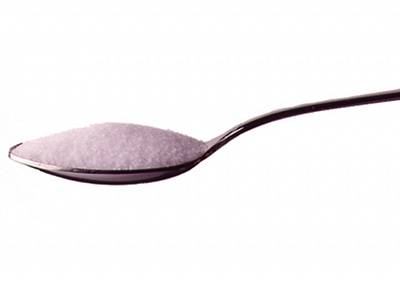 “Sugar Bondage – Why You Need to be Free – Part 4”), you will be amazed and pleased at how quickly your taste buds will adapt. You will also discover how these options will not only satisfy your appetite, but will also get you off the blood sugar “roller coaster”, leaving you with more sustained energy and a sense of well-being, along with a sharper mind and a healthier body.
“Sugar Bondage – Why You Need to be Free – Part 4”), you will be amazed and pleased at how quickly your taste buds will adapt. You will also discover how these options will not only satisfy your appetite, but will also get you off the blood sugar “roller coaster”, leaving you with more sustained energy and a sense of well-being, along with a sharper mind and a healthier body.
So, whether you are wanting to completely cut sugar out of your diet or whether you just want to reduce the amount of sugar you consume, the ideas gleaned from this book (in addition to a few I have found helpful over the years), can put you on the path to achieving those goals.
Defeating any type of addiction can be a battle, and battles are difficult to win if you are not prepared with strategies in addition to stockpiles of weapons. It is too easy to give in and consume tempting foods and beverages if you are not prepared in advance with healthy and appetizing alternatives. The following guidelines will give you some strategies to eliminate as much sugar from your diet as possible.
Top Ten Tips to Get the Sugar Out
Ann Louise Gittleman begins her 501 ways to get sugar out of the diet by giving ten fundamental, yet vital steps that help answer the question “where do I begin?”
- Stop adding sugar to foods and drinks such as cereals, fruits, coffee and tea. Eliminating nutrient-empty processed sugars from your kitchen is a good place to start.
- Eliminate processed carbohydrates, such as white breads, white pasta and white rice from your kitchen, because they are quickly converted to sugars in the body and disrupt the body’s blood sugar and fat control systems just as sugar does.
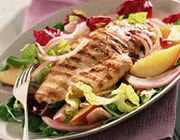
- Stick with unprocessed whole foods. Poultry, meat, fish, eggs, fruits, vegetables, legumes, grains, nuts and seeds are full of nutrients and fiber that help to balance blood sugar.
- Thin out sweeteners or sweet foods, even natural ones. Dilute concentrated sweeteners, like honey, with water and mix sweet foods like granola with non-sweet foods such as plain cereal and nuts to reduce the total sugar consumed.
- Beware of fat free foods, as they are sugar-rich and typically contain two to three times more sugar than the regular version.
- Choose foods as close to a natural state as possible - the more processed a food is, the more it will raise your blood sugar. As examples, choose an orange rather than orange juice, brown rice instead of white, an apple instead of applesauce, etc.
- Become a food detective – identify foods with a high or hidden sugar content by checking the total grams of sugar on the food label. As a general guideline, look for foods that contain no more than three grams of sugars per serving.
- Eat for taste and good nutrition, not just taste alone. It is more important to meet your fundamental nutrient requirements than to just satisfy your taste buds.
- Listen to your body and pick those foods that make you feel good over the long term. If you eat a food that gives you an initial high but later leaves you lethargic, irritable and depressed, don’t eat that food again.
- Eat regular, balanced meals. The body operates more efficiently when meals and snacks contain approximately 40% carbohydrates, 30% protein and 30% fat. This formula keeps the body’s blood sugar in the optimal zone for four to five hours. If you have balanced blood sugar levels, you will have better concentration, better mood, greater energy and stamina and you will be less tempted to grab something sweet.
Getting Off to a Great Start
Starting the day with the right fuel by having a nutritious breakfast containing adequate amounts of protein is a primary way to avoid drops in blood sugar levels that can lead to cravings later in the day. Many common breakfast items should be avoided.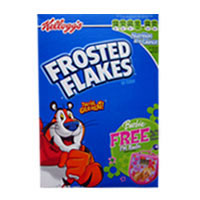
Avoid:
- Cereals high in sugar
- Pastries, donuts, muffins, pancakes, or any food item that contains white flour, sugar or hydrogenated or partially hydrogenated fats. Also avoid items such as fat free muffins, which can have as much or more sugar than cakes or cookies.
- Pancake and waffle syrups, which contain various types of sugar (including high fructose corn syrup)
- High sugar ham, bacon and sausage
- Fruit juice – even 100% juice has high concentrations of sugar that will cause blood sugar levels to spike. An eight ounce glass of apple or orange juice has the natural sugars of four or more pieces of the fruit, but is missing many of the nutrients and all of the fiber contained in the pulp and skin (which helps to slow down the release of sugar into the system).
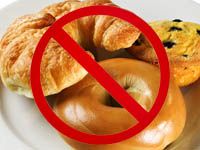
- Coffee is bad for blood sugar because caffeine strains the pancreas and adrenals and causes blood sugar balancing minerals to be washed out of the system. Coffee with sugar is a double whammy in that sugar stimulates insulin release by the pancreas and the caffeine prompts the adrenals to induce the liver to convert its stored glucose (glucagon) into even more sugar in the bloodstream.
Here are suggestions for reducing sugar and increasing the nutrient (especially protein) and fiber content of breakfast foods:
Good Choices:
- Use low sugar (three grams or less) whole grain boxed cereals or make your own low sugar granola (recipes are given in Gittleman’s book). Fresh or dried fruits can be used as a natural cereal sweetener.
- Prepare oatmeal or other cooked cereals using whole grains (if you are short on time in the morning, the author gives an easy method for making “overnight”
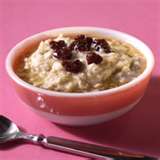 whole grain cereal by taking 2 ½ cups boiling water, 1 cup whole grains and a teaspoon of salt, placing it in a 350Ëš preheated oven and then reducing the heat to 200Ëš and leaving it for a minimum of two hours or overnight)
whole grain cereal by taking 2 ½ cups boiling water, 1 cup whole grains and a teaspoon of salt, placing it in a 350Ëš preheated oven and then reducing the heat to 200Ëš and leaving it for a minimum of two hours or overnight) - Use high protein ingredients such as nut butters, seeds, eggs (helps blood sugar metabolism) or incorporate supergrains such as quinoa or amaranth when making muffins or pancakes.
- Use lean meat or low fat breakfast meats without sugar or, better yet, make your own homemade turkey sausage using the recipe in the book.
- Make your own muffins using natural sweeteners (see my articles on “Healthy Sweeteners – Parts 2 and 3” to learn about various natural sweeteners), adding ingredients such as applesauce, mashed bananas, pumpkin puree, peanut butter, cottage cheese, nuts, seeds, etc. to lessen sugar content and increase protein content.
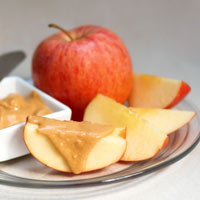
- Use whole grain pancake mixes, adding fresh fruit in addition to any of the above ingredients.
- Use other toppings on toast, muffins, or pancakes, such as all-fruit spreads (may be diluted with water) instead of jam or jelly, unsweetened apple butter or applesauce, low fat cheese or yogurt cheese.
- If you are going to use syrup, only use 100% pure maple syrup and thin it with flax seed oil (great way to get more Omega-3 in your diet), almond milk or water, because the sugar in the maple syrup is highly concentrated. Better yet, make your own fruit syrup by cooking down fresh fruit and adding a very small amount of stevia, agave nectar or other natural sweetener if the result is not as sweet as you want it to be.
- Use whole grain breads with the lowest amount of sugar or use sprouted bread that is particularly good tasting as the germination process converts some of the grain’s starches to sugars. Toasting bread also brings out its sweetness.
- Use butter for a sweet touch, as a little fat is balancing to the blood sugar and improves the ratio of insulin to glucagon.
- Thin out fruit juice with water or herbal tea, or better yet, eat the whole fruit.
- Use grain-based or herb-based coffee substitutes that can provide coffee flavor without the caffeine. Use natural flavorings such as almond and vanilla, if you are used to flavored coffee.
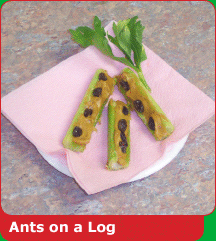 Snack Your Way to Sugar Freedom
Snack Your Way to Sugar Freedom
One of the secrets to losing weight and avoiding drops in blood sugar is to have a nutritious high protein snack every few hours between meals. Not only will a healthy snack keep you alert and energetic, but it will also lessen the likelihood that you will develop cravings and consume something sweet, especially at times when you are stressed, overworked or extra tired. The best times for these snacks are mid-morning, mid-afternoon and a couple of hours after dinner (if you are prone to eating midnight snacks). Any time that you know you will be away from home for a period of hours, whether with work, travel, doing errands or on a recreational outing, plan ahead and pack sugar free snacks from home to avoid getting hungry and eating something you shouldn’t. It’s also a good idea to eat a protein-rich snack before attending an event or gathering where you know there will be tempting desserts.
Ann Gittleman’s book contains many ideas as well as recipes for healthy, high-protein snacks. She calls her favorite snack idea “one of the most innovative coping strategies I know of to help get the sugar out of your diet”. This unique and nutritious snack is referred to as “meal-in-a-muffin”, a phrase coined by cookbook author Jane Kinderlehrer in her book “Smart Muffins”. These muffins can be prepared and frozen ahead to have on hand for quick breakfasts and lunches on the run, in addition to hearty snacks that meet the body’s need for protein, carbohydrates and fats in the right proportions. “Pizza Muffins” and “Zesty Black Bean and Rice Mini-Muffins” are two of the recipes from the book “Smart Muffins” that Ann Gittleman particularly recommends and shares with her readers. Some other ideas for healthy, sugar free snacks are:
- Low fat cheese on whole grain crackers
- Celery with nut butter (cream cheese and hummus also work well)
- Nuts - avoid roasted nuts as “bad” oils that produce transfats are used in the roasting process. Also, avoid dry roasted nuts that often use sugar in the dry roasting process. You can roast your own raw nuts at home by baking them at 275 for 5-15 minutes, or just eat them raw (for better digestion, soak nuts in water; this releases the enzyme inhibitors contained in them). Almonds are particularly high in protein and beneficial for keeping blood sugar levels stable.
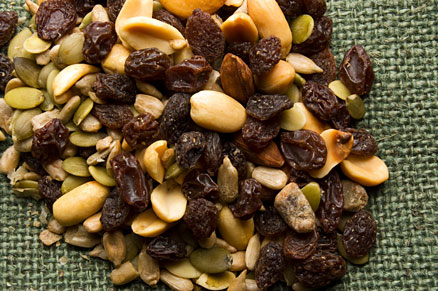
- Trail mix with nuts, seeds and minimal amounts of dried fruit (no M & M’s!)
- Unsweetened bean spreads and/or guacamole on whole wheat tortillas
- Multi grain tortilla chips topped with items such as mashed pinto beans, melted cheese, guacamole, no sugar organic salsa, etc.
- Vegetable “chips” and dip (low sugar dip recipes are provided in the book)
- Low sugar granola or granola bars (recipes such as “Oat Granola” “Almond-Oat Squares” and “Pumpkin Granola Bars” are provided in the book)
- Unsweetened nut butter on apple, pear or banana slices (Granny Smith apples are a good choice as they rate lower on the glycemic index scale)
- Unsweetened yogurt sweetened with fresh fruit. A small amount of stevia as well as natural flavorings, such as almond or vanilla, may also be used to increase flavor
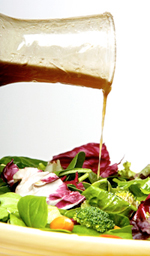 Additional Tips for Lunch and Dinner
Additional Tips for Lunch and Dinner
When it comes to other meals, the author point out that there can be problems with sugar even with healthy food selections, such as soups and salads. It is important to check labels carefully for hidden sugars in canned soups, especially fat free varieties. Salads are a great option for health, but beware of the sugar content of salad dressing. Stay away from fat free dressings and those made with fruit-flavored vinegars (they are higher in sugar). The author gives tips for making broth for soups, nutritious salads and homemade sugar-free salad dressings. A simple but very healthy dressing can be made by combining extra virgin olive oil with lemon or lime juice and crushed garlic, herbs or other seasonings to taste. She advises against using bacon bits (generally contain sugar and/or HFCS) and tells how to easily make whole grain croutons rather than use the ones from the grocery store that are made with white flour.
With regard to meats, the author encourages people to stick with unprocessed meats that are baked, broiled or stir-sautéed. Most hot dogs and processed luncheon meats should be avoided as they contain hidden sugars, not to mention harmful nitrates and other chemical preservatives. Lean meats actually support the adrenal glands, which is an important factor for blood sugar stabilization. However, if you do have a nice cut of steak, don’t indulge in steak sauce -- the sugar content of just two tablespoons of this condiment is equivalent to ½ cup of chocolate pudding! This problem with sugar content extends to other popular condiments such as ketchup, which has more sugar per ounce than ice cream!
Other ideas and recipes pertaining to meals covered in this book include: how to choose the best vegetables, grains, legumes and beans that do not raise the blood sugar levels; how to make “oven fried” chicken and fish (yes, those prepared mixes contain sugars, white flour and harmful preservatives); and how to create low-sugar pasta and barbeque sauces. 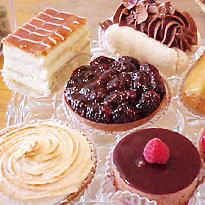 Handling the Biggest Temptations
Handling the Biggest Temptations
The area in which most people need the most help to “get the sugar out” is . . . rich desserts. Granted, a person cannot simply switch overnight from really sweet desserts to low sugar desserts, since it has taken years to get used to the amounts of sugar they currently consume. It can take time to work at reducing the amounts of sugars in desserts and retrain the “sweet tooth” to where those super-sweet desserts made from refined sugars can be more easily resisted.
Even when the strong physical addiction to sugar has been broken and the taste buds have been reset to better enjoy the natural sweetness of foods and smaller amounts of natural sweeteners, psychological cravings for those special “treats” can still exist. However, once you get through the adjustment period, the many ideas and recipes in this book for minimally sweetened desserts and treats can be a huge help in providing ways to satisfy those psychological desires without compromising your health. In her book, Ann Gittleman also gives many wonderful ideas for party foods and beverages, even providing a recipe for a healthy birthday cake. The best part about these ideas and recipes for special treats is that the ingredients are full of healthy nutrients. As she says, rather than being desserts to “die for”, they are desserts to “live for”.
Healthy Dessert Options
Here are some of the “guilt free” options given in this book that you can choose when you are in the mood for a special treat or when you want something healthy to serve or to bring for a social occasion:
- Fresh fruit in season – festive fruit kabobs or a colorful fruit salad served in a watermelon or pineapple boat is an attractive and easy treat everyone will enjoy. For an extra special treat, a recipe for “Chocolate-Coated Fruit Party Platter” is included that uses unsweetened chocolate squares, apple juice concentrate, butter and vanilla extract for the dip
- Other unique fresh fruit ideas given include squeezing fresh lime juice on honeydew melon for a different twist or spreading a teaspoon of olive oil over a half of grapefruit to neutralize the acid and increase the sweetness in lieu of using sugar (it needs to stand several hours before serving to work)
- Gelatin salads made with unsweetened gelatin, fruit juice and fresh fruit
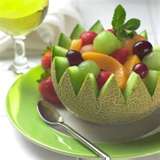
- Cooked fruit ideas include recipes for stuffed baked apples, “Vanilla Pears”, “Peach Cobbler Pie”, “Cherry Crisp with Double-Oat Topping”, to name a few
- Frozen fruit desserts and treats such as fruit smoothies, sorbet and popsicles made from frozen pureed fruit, “Gone Nutty” frozen bananas, and “Last-Minute Fruit Mélange”
- Healthy vanilla and chocolate ice cream recipes
- Pudding recipes such as “Peanut Butter Pudding” and “Brown Rice Pudding”
- Sweet starchy vegetables (sweet potatoes, pumpkin, carrots, winter squash and beets) can be used to make everything from sweet breads to whipped mousse desserts
- Cookie recipes such as “Oatmeal-Chocolate Chip Cookies” (using grain or malt sweetened chocolate chips) and “Lemony Almond Macaroon Drops”
- Carrot Cake, Chocolate Cake and No-Bake Pineapple Cheesecake recipes are given as well as ideas for making strawberry shortcake using whole grain Belgian waffles. Quick breads such as whole-wheat zucchini bread can also be served as cake-like desserts. Frosting recipes in the book include yogurt cheese, whipped cream, cream cheese, pineapple, carob and chocolate.
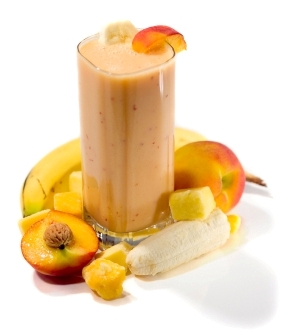
- Natural candy ideas, like using frozen grapes or blueberries as hard candy, dates stuffed with nut butters, peanut butter-carob balls and small amounts of naturally sweetened chocolate are suggested as well
Another wonderful frozen treat not included in the book can be made if you are blessed to own a juicer with a homogenizer feature. Frozen bananas or other frozen fruit can be run through the homogenizer to become the equivalent of “soft serve” ice cream. You can eat it as is or add various toppings such as nuts, fresh fruits, all fruit preserves, homemade carob or chocolate syrup, fruit syrups or whipped topping, made using natural sweeteners. It can be served over whole-wheat waffles or with healthy homemade cookies, cakes or pies – all made using no refined sugars or flours.
Learning Traits of Moderation and Restraint
Because there will be those times of special occasions, vacations and holidays when you may indulge in not-so-healthy desserts and treats made with refined sugars and other unwholesome ingredients, it would certainly be better to enjoy a sweet treat every once in a while rather than restrict yourself to the point where you end up going on a sugar binge. Learn the art of moderation and, if you do eat a sugar treat, have a small serving and eat it slowly, savoring each small bite. Eat it in conjunction with a well-balanced meal so that the protein and other foods will help to slow down the spiking of blood sugar.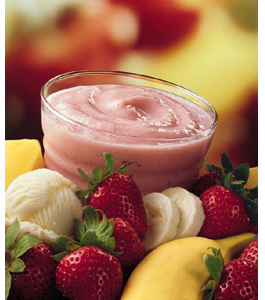
Bear in mind, however, that when you indulge in refined sugar desserts, you can set off the blood sugar “roller coaster” cycle with accompanying cravings, making it more difficult to resist the next time you are tempted. It may also require going through the process of abstaining from all forms of sugar in order to “reset” your taste buds once again to return to a state of complete freedom from cravings and addictive tendencies.
Conclusion
Ann Gittleman reminds people that the decision to keep sugar out of your life is a commitment to health that needs to last a lifetime. One of the many valuable suggestions she has for ensuring success is to post a positive affirmation to reinforce your commitment to eat for health and lick the sugar habit. A woman she knew with severe health problems posted this affirmation on her refrigerator where she saw it every day: “I want and deserve to take good care of myself. I can pass up sugar and be totally happy about it because I am replacing temporary, short-lived satisfaction in exchange for the greater satisfaction of long-term, radiant health.” May this woman, who is now free of her health problems as well as her sugar addiction, be an example to us all.
Source:
“Get the Sugar Out – 501 Simple Ways to Cut the Sugar Out of Any Diet” by Ann Louise Gittleman, M.S., C.N.S.
Ann Louise Gittleman is a nationally recognized nutritionist who has been a consultant to a number of prestigious medical institutions, clinics, and spas. Her other books include “Supernutrition for Women”, “Supernutrition for Menopause”, “Supernutrition for Men”, and “Your Body Knows Best”.
Note to Readers:
If you are interested in getting your own copy of Ann Louise Gittleman’s book, which has many of the recipes I alluded to in this article, you can buy it through Amazon second hand for as little as $1.79 (plus $3.99 shipping, of course). The copyright date on the edition I got second hand, is 1996. There is a newer version that was released in January of 2008 and it sells new on Amazon for $11.16. Happy reading!
Copyright © 2008-2015 Lucinda Bedogne, CNHP, CNC
Reader Comments...
| 2009-09-13 23:50:49 "Great article and information. I love all the tips and suggestions. I am proud of you, Mom! " - Jessica |
Post Your Comment...
|
|
||||||||||||


